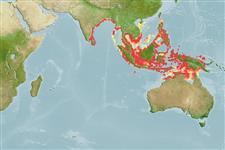>
Clupeiformes (Herrings) >
Engraulidae (Anchovies) > Engraulinae
Etymology: Stolephorus: Greek, stole, -es = garment + Greek, pherein = to carry (Ref. 45335).
Environment: milieu / climate zone / depth range / distribution range
Ecologia
marino; distribuzione batimetrica 0 - 50 m (Ref. 189). Tropical; 22°N - 15°S, 78°E - 148°E (Ref. 189)
Indo-Pacific: eastern Indian Ocean (eastern coasts of India around Waltair, but perhaps along most of the coast) and western Pacific (Singapore and Gulf of Papua, but presumably between).
Size / Peso / Age
Maturity: Lm ? range ? - ? cm
Max length : 5.0 cm SL maschio/sesso non determinato; (Ref. 189)
This species is distinguished by the following set of characters: gill rakers 33-37 (35) in first gill arch with 14-16 (modally 14) in upper series, 19-21 (21) in lower series; gill rakers 26-29 (29) in second gill arch, with 8-11 (10) in upper and 16-19 (19) in lower series; gill rakers 17-19 (19) in third gill arch with 7-8 (8) in upper and 10-11 (10) in lower series; gill rakers 14-16 (14) in fourth gill arch with 5-8 (6) in upper and 8-9 (8) in lower series; branchiostegal rays 10-11 (11); upper jaw long, posterior tip slightly short of or just reaching posterior border of opercle; without predorsal scutes; pelvic scute no spine-like projection; posterior border of preopercle is indented, concave; posterior tip of depressed pelvic fin does not reaching to vertical through dorsal-fin origin; anal-fin origin just below eighth to tenth dorsal-fin ray origin; length of caudal peduncle, 16.9-19.9% of SL, of pectoral fin, 13.2-14.4% of SL and of pelvic fin, 7.4-8.9% of SL. Colouration: with a pair of dark patches behind occiput without a following pair of dark lines; absence of black spots below eye or on lower-jaw tip (Ref. 124189).
Schooling species occurring in coastal waters (Ref. 189, 75154). Eggs are oval, without a knob. More material and data needed.
Life cycle and mating behavior
Maturità | Riproduzione | Deposizione | Uova | Fecundity | Larve
Hata, H., S. Lavoué and H. Motomura, 2020. Stolephorus acinaces, a new anchovy from northern Borneo, and redescription of Stolephorus andhraensis Babu Rao, 1966 (Clupeiformes: Engraulidae). Mar. Bio. 50:102. (Ref. 124189)
IUCN Red List Status (Ref. 130435)
Threat to humans
Harmless
Human uses
Pesca: di nessun interesse
Informazioni ulteriori
Nomi ComuniSinonimiMetabolismoPredatoriEcotossicologiaRiproduzioneMaturitàDeposizioneSpawning aggregationFecundityUovaEgg development
BibliografiaAcquacolturaProfilo di acquacolturaVarietàGeneticaElectrophoresesEreditarietàMalattieElaborazioneNutrientsMass conversion
CollaboratoriImmaginiStamps, Coins Misc.SuoniCiguateraVelocitàModalità di nuotoArea branchialeOtolithsCervelliVista
Strumenti
Special reports
Download XML
Fonti Internet
Estimates based on models
Preferred temperature (Ref.
123201): 27.7 - 29.2, mean 28.6 °C (based on 838 cells).
Phylogenetic diversity index (Ref.
82804): PD
50 = 0.5000 [Uniqueness, from 0.5 = low to 2.0 = high].
Bayesian length-weight: a=0.00562 (0.00259 - 0.01222), b=3.18 (3.00 - 3.36), in cm total length, based on LWR estimates for this (Sub)family-body shape (Ref.
93245).
Trophic level (Ref.
69278): 3.2 ±0.4 se; based on size and trophs of closest relatives
Resilienza (Ref.
120179): Alto, tempo minimo di raddoppiamento della popolazione meno di 15 mesi (Preliminary K or Fecundity.).
Fishing Vulnerability (Ref.
59153): Low vulnerability (10 of 100).
